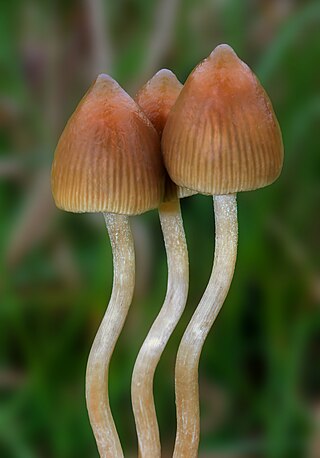
Psilocybin mushrooms, commonly known as magic mushrooms or shrooms, are a polyphyletic informal group of fungi that contain psilocybin, which turns into psilocin upon ingestion. Biological genera containing psilocybin mushrooms include Psilocybe, Panaeolus, Inocybe, Pluteus, Gymnopilus, and Pholiotina.

Psilocybe is a genus of gilled mushrooms, growing worldwide, in the family Hymenogastraceae. Many species contain the psychedelic compounds psilocybin and psilocin.

Psilocybe semilanceata, commonly known as the liberty cap, is a species of fungus which produces the psychoactive compounds psilocybin, psilocin and baeocystin. It is both one of the most widely distributed psilocybin mushrooms in nature, and one of the most potent. The mushrooms have a distinctive conical to bell-shaped cap, up to 2.5 cm (1 in) in diameter, with a small nipple-like protrusion on the top. They are yellow to brown, covered with radial grooves when moist, and fade to a lighter color as they mature. Their stipes tend to be slender and long, and the same color or slightly lighter than the cap. The gill attachment to the stipe is adnexed, and they are initially cream-colored before tinting purple to black as the spores mature. The spores are dark purplish-brown in mass, ellipsoid in shape, and measure 10.5–15 by 6.5–8.5 micrometres.

Psilocybe azurescens is a species of psychedelic mushroom whose main active compounds are psilocybin and psilocin. It is among the most potent of the tryptamine-bearing mushrooms, containing up to 1.8% psilocybin, 0.5% psilocin, and 0.4% baeocystin by dry weight, averaging to about 1.1% psilocybin and 0.15% psilocin. It belongs to the family Hymenogastraceae in the order Agaricales.

Panaeolus cinctulus, syn. Panaeolus subbalteatus, commonly known as the banded mottlegill, weed Panaeolus, belted panaeolus, or subbs is a very common, widely distributed psilocybin mushroom. According to American naturalist and mycologist David Arora, Panaeolus cinctulus is the most common psilocybin mushroom in California.

Panaeolus is a genus of small, black-spored, saprotrophic agarics. The word Panaeolus is Greek for "all variegated", alluding to the spotted gills of the mushrooms produced.

Panaeolus tropicalis is a species of psilocybin producing mushroom in the family Bolbitiaceae. It is also known as Copelandia tropicalis.

Pluteus is a large genus of fungi with over 300 species. They are wood rotting saprobes with pink spore prints and gills that are free from the stem.

Inocybe aeruginascens is a member of the genus Inocybe which is widely distributed in Europe. The species was first documented by I. Ferencz in Ócsa, Hungary on June 15, 1965.

Panaeolina is a small genus of small mushrooms, containing only about four species. They are a subgroup of Panaeolus which have dark brown spores. The type species is Panaeolina foenisecii, a common lawn mushroom. Members of Panaeolina are broadly distributed throughout the world.

Panaeolus cyanescens is a mushroom in the Bolbitiaceae family. Panaeolus cyanescens is a common psychoactive mushroom and is similar to Panaeolus tropicalis.

Aeruginascin or N,N,N-trimethyl-4-phosphoryloxytryptamine is an indoleamine derivative which occurs naturally within the mushrooms Inocybe aeruginascens, Pholiotina cyanopus, and Psilocybe cubensis. Aeruginascin is the N-trimethyl analogue of psilocybin. It is closely related to the frog skin toxin bufotenidine (5-HTQ), a potent 5-HT3 receptor agonist, but the aeruginascin metabolite 4-HO-TMT shows strong binding at the 5-HT2 receptors similar to psilocin. The first scientific literature about the pharmacological effects of aeruginascin is from a study published by Gartz in 1989. Across 23 analyzed cases of accidental hallucinogenic mushroom poisonings, people who had ingested the mushroom Inocybe aeruginascens reported only euphoric experiences. This is in contrast to the slight and in some cases extremely dysphoric experiences reported from the accidental ingestion of non-aeruginascin-containing mushrooms (containing solely psilocybin and psilocin).
Panaeolus moellerianus is a species of mushroom in the Bolbitiaceae family.

Panaeolus rubricaulis is a species of mushroom in the Bolbitiaceae family.
Panaeolus venezolanus is a species of mushroom in the Bolbitiaceae family. This species of mushroom has a cap with a diameter of 20–35 mm and has a brownish gray to ashy gray color.
Panaeolus coprinifacies is a species of mushroom in the family Hymenogastraceae.
Psilocybe mairei is a species of mushroom in the family Hymenogastraceae. It is found in Algeria and Morocco and contains the psychoactive compound psilocybin. The oldest example of rock art suggesting use of psychedelic mushrooms might depict P. mairei. In 1992 the Italian ethnobotanist Giorgio Samorini reported finding a painted mural from Tassili n'Ajjer in the Sahara desert in southeast Algeria, dated 7000 to 9000 BCE, portraying mushrooms.
Psilocybe uxpanapensis is a species of entheogenic mushroom in the family Hymenogastraceae. The mushroom contains the hallucinogenic compounds psilocybin and psilocin. Mexican mycologist Gastón Guzmán described this mushroom in 1979 as a novel species: the first hallucinogenic mushroom to be discovered in an undisturbed tropical forest. Psilocybe uxpanapensis is one of the many tropical species of fungi in Mexico at risk of disappearing due to deforestation.
Panaeolus lentisporus is a species of psychoactive mushroom belonging to the genus Panaeolus, and classified under the family Bolbitiaceae. It is native to Papua New Guinea and some parts of Asia. The fungus was first described by E. Gerhardt in 1996. It is very similar to Panaeolus affinis, and should not be confused with it.










